“A perfectly shucked oyster slides out of its shell and onto your tongue; its silky, cold texture lights up your senses. The brine is electric and the animal itself is exotic. The sweetness you get from the adductor muscle is delightful and you’re teleported to that body of water it was raised in. And just like that, the oyster has seduced you once again.”
These are the poetic words of Brooke Kotack, Front of House Manager, Shucker, and Oyster Purchaser at Rodney’s Oyster House in Toronto. I would expect no less passion from someone who works at Rodney’s, which is known as an institution in Canada when it comes to oyster bars. Founded in 1987 by legendary “Oysterman” Rodney Clark of PEI, Rodney’s also has a location in Calgary. Brooke and her team at Rodney’s Toronto shuck a lot of oysters – a record of 4,500 in one service, to be exact. Another record was set once at the annual Ontario Oyster Festival (hosted by Rodney’s) – 18,000 oysters were shucked during that year’s festival. Having just celebrated its 34th year after a 2-year pandemic hiatus, the festival gathers shuckers and enthusiasts from across the country. Said Brooke, “people come to celebrate the oyster, cheer on their favourite shucker in the Ontario Oyster Opening Championships and drink and dance the night away.” The proceeds from the event go to an environmentally-focused charity that is selected annually.
Brooke, like the others I spoke to for this month’s column simply loves oysters. Her ideal plate would include, “some Sweet Blue Label Selects from Cascumpec Bay, PEI; some Glidden Point Selects from the Damariscotta River in Maine; some Totten Virginicas from Washington; and some Little Harbor’s from Mass.” She would add lemon and horseradish to all of them, and garnish a few with shallot vinaigrette, and others with Rodney’s “white boy soul sauce”. She might add a dash of green Tabasco, but she cautions against using too much sauce because “it’s disrespectful to the oyster.”
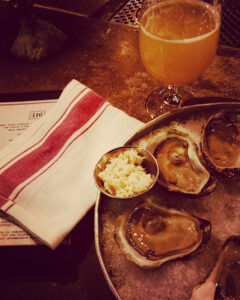
Oysters at one of my favourite spots: 416 Snack Bar, Toronto, February 2022.
I have to admit that I too have also been seduced by the oyster. There’s something sublimely primal about a craggy rock-like shell that once opened, contains the essence of the sea in food form. I love the salty, briny flavour. I love receiving a plate of them beautifully arranged on ice. I love the ritual of sipping the oyster liqueur, tipping my head back, and slurping the oyster into my mouth. I love the practice of turning the shell over and returning it to the bed of ice, only to start this ritual all over again.
As a child, my only references for oysters were either whimsical animated shells boasting shiny pearls or stories from my Dad about my grandparents’ special occasion dinners where they feasted on Oysters Rockefeller. I was well into my thirties before I tasted a raw oyster.
There are many different species of oysters, some more salty and briny, some pungent, some sweet and creamy, and some grassy. Oysters are a good source of protein that contain copper, zinc, selenium, iron, and vitamin B12, and these days you are more likely to eat a farmed oyster vs. a wild one. According to Brooke, some oysters can take years to grow to market size. She said, “the Atlantic Oyster (Crassostrea Virginica) takes 3-4 years, whereas the Pacific Oyster (Crassostrea Gigas) takes only 18 months. Water temperature plays a big role in this.”
They’re not just a current culinary trend – they’re timeless. Said Brooke, “Oysters are only getting more and more popular, so much so that farmers are having a hard time keeping up with the demand. Covid restrictions came to an end and people have been just crushing oysters ever since.” She continued, “Oysters won’t ever go out of style; sharing a plate of oysters is intimate, alluring and you can feel good about it because not only are they extremely nutritious but they are carbon sequestering machines. Oyster farming is a force on the environmental side of things — the more oysters there are in our oceans, the better off we are. A single oyster filters up to 50 gallons of water per day.”
To share everything there is to know and appreciate about oysters would have you reading for days, but I wanted to give you a taste of this beautiful bivalve, so I rallied some shuckers, chefs, and a sommelier to help me guide you through this love letter to the oyster.
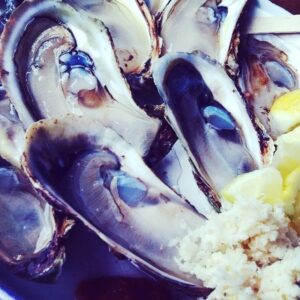
Freshly shucked oysters at the Bytowne Oyster Festival in Ottawa, 2017.
I live in Ottawa, so I certainly couldn’t write about oysters without speaking to someone at Whalesbone, and all signs pointed to the first oyster shucker I met in my early days after moving here: Jesse Papastavros.
Director of Catering and Events for this well-loved Ottawa restaurant group and retail operation, Jesse was inspired to start shucking oysters approximately 10 years ago when he was a cook and dishwasher at their former Bank Street location. He shared, “I was hearing the stories that the guys came back with about their oyster shucking travels and I said to myself – this sounds like a fucking time! Wild tales of travel and oyster competitions – I realized I wanted to be opening oysters, that I wanted some of that action.”
A decade later, Jesse has likely lost count of how many oysters he’s shucked, whether for service, an event or at a competition. When I asked him for some shucking tips, he began by saying, “First you have to forget everything you know about knife safety. Oyster shucking goes against everything you’ve ever learned on how to handle a knife.”
He continued, “You want to find a perfect mix between power and finesse – it requires about twenty-plus pounds of pressure and enough finesse to drive through the oyster without damaging the meat, or the gills. We eat with our eyes first, so to see a beautiful product is half the battle. Shell is bound to happen if you grind on the hinge too much – you wear away the shell, but if you can avoid that, a well-opened oyster is going to taste 100 times better than a damaged oyster.”
Chris Manocchio, an oyster shucker at Rodney’s also provided some shucking advice, “Don’t force it”, he said. “An oyster will let you know when it is ready to open after working it in the right spot.”
When I spoke to Jesse, he was just returning from the Ontario Oyster Festival, so I asked him what he loves about shucking competitions. “It’s a rare opportunity to gather a lot of like-minded people in the same place from a weird and interesting subculture”, he shared. “We are like a hive mind of farmers and shuckers – all about the oysters.”
“I used to think you have to be first off the table, top 5”, Jesse said, reflecting on past competitions. “It feels great to win, but as I get older, half the fun is the fellowship with like-minded people who you don’t usually get to see because everyone is so busy. The competitions are a great chance to test your mettle with the best oyster shuckers. It’s like a Christian sing-along with a lot of beers.”
Speaking of beer, it’s one of a few components that would make an ideal snack of oysters for Jesse. “The oyster gives of itself to enjoy – it should be like kissing a mermaid, not just a mouthful of hot cheese and garlic”, he stated. Jesse’s ideal oyster snack includes, “a nice cold beer and a glass of bourbon – lemon and lips — that’s all you need. Oysters are just like a french kiss”, he says, then quickly adds, “…to quote Rodney Clark.”
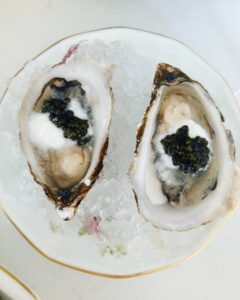
Oysters with sturgeon caviar and crème fraîche. Le Poisson Bleu, Ottawa, July 2022.
During a recent oyster appreciation tour, I visited a relatively new Ottawa restaurant – Le Poisson Bleu. Co-owned by brothers Eric and Alex Bimm with their cousin and Bar Chef Sophie Bertrand, Le Poisson Bleu is a quaint and stylish neighbourhood restaurant and bar that offers warm hospitality and celebrates “unique seafood”.
The first time I visited Le Poisson Bleu I stepped outside of my raw oyster comfort zone and enjoyed a hot oyster preparation that was on the menu that night, with a garnish of XO sauce. This time, when I asked Chef Alex about this choice of sauce, he explained, “The layers of deep umami flavour in an XO sauce go so well with an oyster. The umami of the sauce compliments the umami of the seafood. This is an example of how oysters can stand up to bold flavours.”
When I asked Alex why he loves oysters, he simply replied, “I’m a seafood chef – and an oyster is the perfect description of how the ocean tastes.” He continued, “There’s no right or wrong way to eat an oyster. They are good cold or hot – hot can be just as delicious. But – you can’t beat a raw oyster – it’s perfect.”
Although both brothers enjoy the purity of a raw oyster, when it comes to seafood in general, Alex posited that “the world view of seafood is starting to shift when it comes to the rules – Chefs are pushing boundaries.” My own boundaries were pushed when I garnished one of my oysters with a spoonful of chermoula, an Iranian chimichurri with cumin, coriander, and fig. Although I tend to be a bit of an oyster purist, I couldn’t deny that it tasted really good. My favourite of the night, however, was the beautifully plated oyster duo topped with a perfect amount of sturgeon caviar and crème fraîche.
Equally appreciative of both hot and cold preparations, Alex added, “Cold water seafood is my wheelhouse because there is more pure oyster flavour, but I love West coast too, especially for hot preparations – they are bigger and stand up to the heat.”
When I asked how the Brothers Bimm would most enjoy a plate of oysters, Alex said he would opt for a simple splash of classic mignonette and a glass of Pheasant’s Tears wine, while Eric would choose a glass of bubbles or sake to accompany some West coast oysters garnished with lime and fresh wasabi.
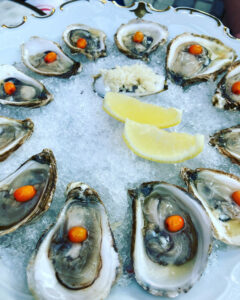
Oysters with Seabuckthorn berries, North and Navy, Ottawa, August 2020.
I enjoyed another unique oyster garnish two summers ago on the patio at North and Navy (NoNa), an excellent Northern Italian restaurant in Ottawa. My plate of oysters was playfully garnished with a Seabuckthorn berry, each one placed where you might find a pearl.
I asked Chef de Cuisine Eric Chagnon-Zimmerly, who has been at NoNa for 5 years, what inspired him to choose this and other garnishes when oysters are on his menu. “I love a little hit of acid as this caters well to our wines and the rest of our food style”, he said. “A couple of favourites we’ve played with over the years are house-made fruit vinegars or Seabuckthorn berries (a very tart, bright orange berry). I like that these give that pop of flavour without overpowering the delicate oyster.” He also confirmed my love of that playful plating, referring to the berries, “they also visually remind me of a little pearl sitting in its bed and I think that’s a cute look.”
Eric prefers East coast oysters raw, “as I like a cocktail sized, briny oyster for this application. I find some of the larger varieties can be a little clumsy to eat whole in a public setting”, he explained. “That said, If I’m going to bake them, I’ll lean towards the sweeter, often meatier west coast varieties.” In addition to his preference for raw oysters, he also holds a fond memory of a hot oyster preparation he had at Maison Publique in Montreal that was quite substantial and covered in cheese, mayo, and an herb mixture. “In the colder months I’ll gladly tuck into a nice baked oyster”, he said.
Before landing at North and Navy, Eric traveled in Vietnam, and upon returning to Canada, spent time working in a winery cellar in Niagara, and with Chef Jonathan Korecki. His first exposure to oysters as a child involved a lukewarm buffet, but that became a distant memory when he shucked his first oyster at Restaurant E18hteen. “I dressed it simply with a bit of lemon juice, and finally knew what a good oyster should taste like. This one was a little sweet, not too briny, and the pop of acid brightened it up nicely. I’ve generally enjoyed oysters since then”, he said. Now, he usually reserves oysters for a celebratory occasion, and he enjoys them with a classic lemon garnish, fresh horseradish, and a dash of homemade hot sauce. His wine of choice would be a dry, bubbly Rosé.
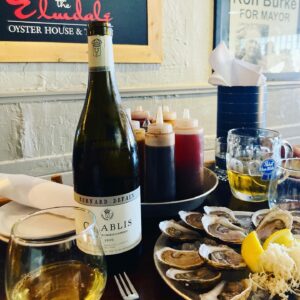
Oysters, Chablis, and PBR, Elmdale Oyster House, Ottawa, July 2022.
Perhaps the reason I love oysters so much is that I love wine. Much like wine lovers speak of the terroir or the “taste of place” of a wine based on its climate, soil, and other influences from mother nature, oysters have “merroir” – the taste of the sea. Oysters’ merroir is even more precise and influential on their taste. According to Jesse Papastavros, “oysters can taste incredibly different even when they are grown in the same bay (e.g. the east or west side of the same bay). What’s happening in the water column and in the water near where oysters grow, and several other factors contribute to the merroir. A stream nearby or a ferry passing by can add an ebb and flow that moves oysters’ food sources around, from sandier to marshier areas. This changes the taste immensely”, he explained.
When it comes to oyster wine pairings, I decided to consult an expert, so I sat down to taste some wine and oysters with Andrew Rastapkevicius, a fellow oyster enthusiast, sommelier and wine agent. Humble, knowledgeable, and well-known in the Ottawa restaurant industry, Andrew works for Lifford Wine and Spirits, and is co-owner of the Byward Wine Market. Inspired largely by the late oyster legend John Bil, Andrew is an oyster aficionado, and he and his wife love to canoe camp, never leaving home without a cooler full of ice, wine, and oysters.
We met at the Elmdale Oyster House and Tavern (Whalesbone) and Andrew brought a bottle of what he believes to be the best wine varietal to pair with oysters: Chablis. Our server Nick treated us to three types of oysters: Puffin Rocks from Newfoundland — the saltiest and both of our favourites, Saint Simones from New Brunswick, and Foxley Rivers from PEI – sweet and salty.
We started by simply tasting each oyster on its own, with no garnish and no sip of wine. “I’m a purist”, Andrew declared. While we both agreed to be a fan of lemon, and at times mignonette and horseradish, I had never tried the blended scotch that typically comes as an option with the condiment tray. So, we each put a few drops on an oyster and slurped it down. He explained that the minerality and iodine qualities of the scotch pair quite well with the oyster. When it comes to those who put hot sauce on oysters, Andrew had this to say, with a cheeky smile: “they should just order some chicken wings and not fuck up some good oysters.”
Like many of the raw oyster enthusiasts I’ve met, Andrew prefers East coast oysters. “West coast are sweeter and more voluptuous but I love the briny, salty, saline quality of East coast.” It doesn’t hurt that the type of wine he likes to drink fits with this flavour profile so well.
Speaking of which, we uncorked an elegant bottle of Chablis to enjoy with the rest of our oysters. This particular bottle was from a family winery outside of Milly, France, on the Côté de Lechet. (Bernard Defaix, 2020).
“Chablis is an embarrassment of riches in minerality – and minerality is the key to a great wine pairing with oysters – specifically East coast oysters because they are more saline, salty, and briny. And personally – that’s what I dig in oysters”, he said.
He went on to explain that Chablis is rich in minerality for two reasons. “The first is the unique Kimmeridgean Limestone and Marl soils. This is a really old, chalky, decomposing form of limestone and compressed clay with limestone. It’s from a time when that part of France and Burgundy was under the ocean and you can find all kinds of fossilized oyster shells and crustaceans in there. So that heavy minerality in the soil is translated in the glass”, he said. “The other main reason is the “sur-lie” style of most Chablis, where the wine stays in contact with the dead yeast cells (lees) for an extended period of time. This amps up the body as well as giving a more minerally, salty, someone yeasty flavour and texture.”
The minerality of the soil combined with the sur-lie style of wine production makes Chablis “one of the most mineral styles of wine in the world”, Andrew explained. “Which is why I rave so much about it paired with oysters that have so much of that same flavour profile with the briny, saline oyster liqueur and they pair together so perfectly without needing any of the sauces or accoutrement.”
I asked him which other wines and beverages would pair well with oysters, and we began to form a list together, which included Champagne, Muscadet, dry or off-dry Riesling, Albariño, Sancerre, New Zealand Sauvignon Blanc, dry French Rosé, or a light lager beer or glass of whisky. Muscadet in particular was intriguing, as it contains 100% Melon de Bourgogne grapes sur lie – which makes it very mineral and crisp. Andrew told me that the Muscadet region is where France gets a majority of its oysters, where the Loire River meets the ocean.
I still have so many questions about oysters – I feel as though I’ve only cracked the shell in my discovery of these magical mollusks. What I do know is, eating them transports me to a rocky coast where I’m breathing the sea air. In my dreams I’m in Ireland, from where most of my ancestors hailed, bundled up on the shoreline shucking oysters, with a bottle of Chablis chilled and ready, and family, friends, and a warm fire nearby.
Until that dream is realized, I will continue my oyster tastings locally, with future hopes of slurping these delicious delicacies not just in Ireland but also in France (of course), Canada’s maritime provinces, Maine, Cape Cod, and B.C., to start with. What intrigues me most as I continue to delve into the world of oysters are mostly questions about their history. One thing for sure is, as I continue to savour every oyster I eat, I’ll heed Jesse’s advice to “sit at the bar and talk to the shuckers about the farmers”, and Brooke’s wise instructions to “sip its liquor, tip the shell into your mouth, and don’t forget to chew.”

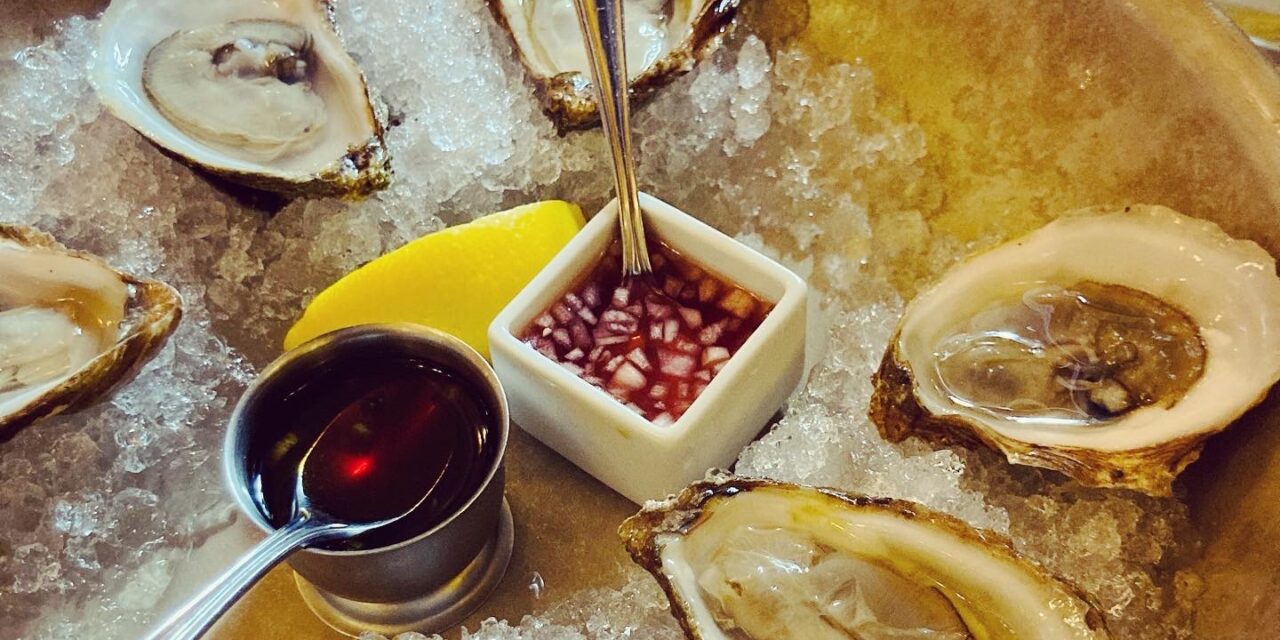

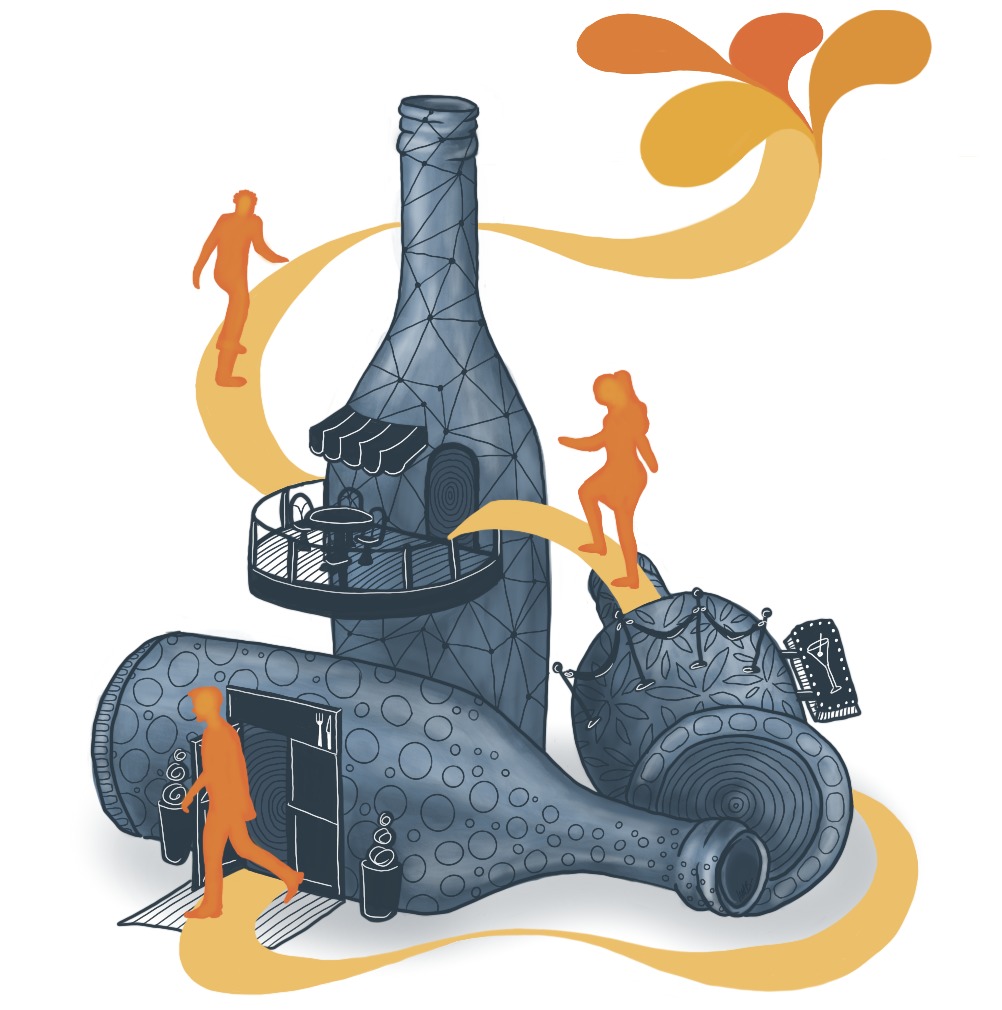




I have never tried oysters but this column presents a strong case in their favour. I am amazed at the popularity of oysters and at the variety of ways to accent them, present them and enjoy them. Maybe I will give oysters a chance?